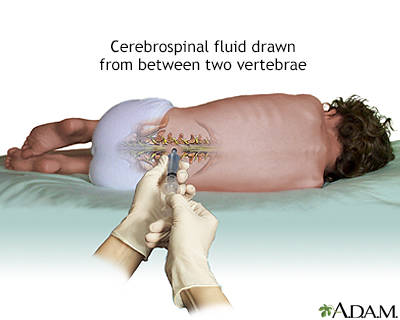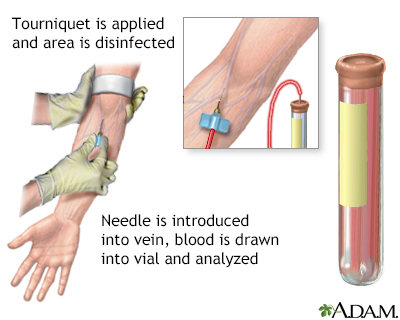
Coccidioides antibody test - spinal fluid
CSF coccidioides complement fixation is a test that checks for infection due to the fungus Coccidioides spp. in the cerebrospinal (CSF) fluid. This is the fluid surrounding the brain and spinal cord. The name of this infection is coccidioidomycosis, or valley fever. When the infection involves the covering of the brain and spinal cord (the meninges), it is called coccidioidal meningitis.


A sample of spinal fluid is needed for this test. The sample is usually obtained by lumbar puncture (spinal tap).
The sample is sent to a lab. There, it is examined for Coccidioides antibodies using a lab method called complement fixation. This technique checks if your body has produced substances called antibodies to a specific foreign substance (antigen), in this case Coccidioides.
Antibodies are specialized proteins that defend your body against bacteria, viruses, and fungi. If the antibodies are present, they stick, or fix themselves, to the antigen. This is why the test is called fixation.
Follow your health care provider's instructions on how to prepare for the test. Expect to be in the hospital for several hours afterward.
During the lumbar puncture procedure:
This test checks if your central nervous system has an active infection from Coccidioides.
The absence of fungus (a negative test) is normal.
If the test is positive for fungus, there may be an active infection in the central nervous system.
An abnormal spinal fluid test means that the central nervous system is infected. During the early stage of an illness, few antibodies may be detected. Antibody production increases during the course of an infection. For this reason, this test may be repeated several weeks after the first test.
Risks of lumbar puncture include:
Aoyagi K, Ashihara Y, Kasahara Y. Immunoassays and immunochemistry. In: McPherson RA, Pincus MR, eds. Henry's Clinical Diagnosis and Management by Laboratory Methods. 24th ed. Philadelphia, PA: Elsevier; 2022:chap 45.
Galgiani JN. Coccidioidomycosis (Coccidioides species). In: Blaser MJ, Cohen JI, Holland SM, et al, eds. Mandell, Douglas, and Bennett's Principles and Practice of Infectious Diseases. 10th ed. Philadelphia, PA: Elsevier; 2026:chap 271.
Thompson GR, Miceli MH. Endemic mycoses. In: Goldman L, Cooney KA, eds. Goldman-Cecil Medicine. 27th ed. Philadelphia, PA: Elsevier; 2024:chap 308.
BACK TO TOPReview Date: 5/12/2025
Reviewed By: Jatin M. Vyas, MD, PhD, Roy and Diana Vagelos Professor in Medicine, Columbia University Vagelos College of Physicians and Surgeons, Division of Infectious Diseases, Department of Medicine, New York, NY. Also reviewed by David C. Dugdale, MD, Medical Director, Brenda Conaway, Editorial Director, and the A.D.A.M. Editorial team.

|
A.D.A.M., Inc. is accredited by URAC, also known as the American Accreditation HealthCare Commission (www.urac.org). URAC's accreditation program is an independent audit to verify that A.D.A.M. follows rigorous standards of quality and accountability. A.D.A.M. is among the first to achieve this important distinction for online health information and services. Learn more about A.D.A.M.'s editorial policy, editorial process and privacy policy. A.D.A.M. is also a founding member of Hi-Ethics and subscribes to the principles of the Health on the Net Foundation (www.hon.ch). |
The information provided herein should not be used during any medical emergency or for the diagnosis or treatment of any medical condition. A licensed medical professional should be consulted for diagnosis and treatment of any and all medical conditions. Call 911 for all medical emergencies. Links to other sites are provided for information only -- they do not constitute endorsements of those other sites. © 1997- A.D.A.M., Inc. Any duplication or distribution of the information contained herein is strictly prohibited.